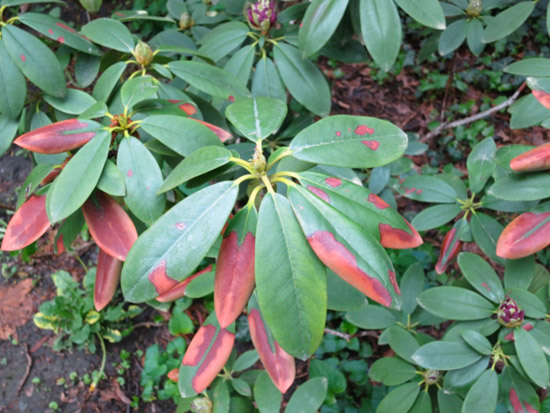Issue 3, May 13, 2013
Rhododendron Winter Burn
This spring, some Rhododendrons are showing symptoms of a form of winter injury known as winter burn (see photo). Symptoms may vary, but winter burn usually results in areas of the affected leaves turning brown. Some leaves show symptoms on the margins and tips while others may brown along the midvein.
Winter burn occurs as a result of water stress. In this case, water lost from the leaf tissues was greater than the amount the roots and stems were able to replenish. Broadleaved evergreens are particularly susceptible to this disorder. They have large areas of exposed leaf tissues that allow for increased water-loss during the winter months.
Several environmental factors contribute to this disorder. In terms of moisture availability, dry or frozen soils may limit how much water the plant intake and provide to the leaves. Planting location can also contribute to the problem. Plants located in unprotected sites, exposed to winter winds or excessive sunlight, have greater water loss and are more likely to show symptoms of winter injury.

Winter Injury/winter burn on rhododendron.
Winter burn to Rhododendrons and other broadleaved evergreens can be prevented by:
- Selecting an appropriate planting location. Rhododendrons should be located where they receive partial shade and protection from desiccating winter winds.
- Maintaining adequate soil moisture, especially in late fall and early winter. Check the soil moisture around plants and irrigate as needed before the ground freezes.
- Applying anti-desiccants. These products are used to reduce winter transpiration and water loss. They need to be applied in the fall and reapplied at labeled intervals.
- Building protective screens to provide shade and windbreaks. They can be constructed with burlap or other materials. Temporary fences, such as snow fencing, can also be effective.
- Rhododendrons also have mechanisms to help protect their leaves from winter injury. You may have observed rhododendron leaves rolling, curling, and drooping on cold winter days. This action in normal and reduces the amount of tissues exposed to direct sunlight and desiccating winds.
(Travis Cleveland)
Author:
Travis Cleveland